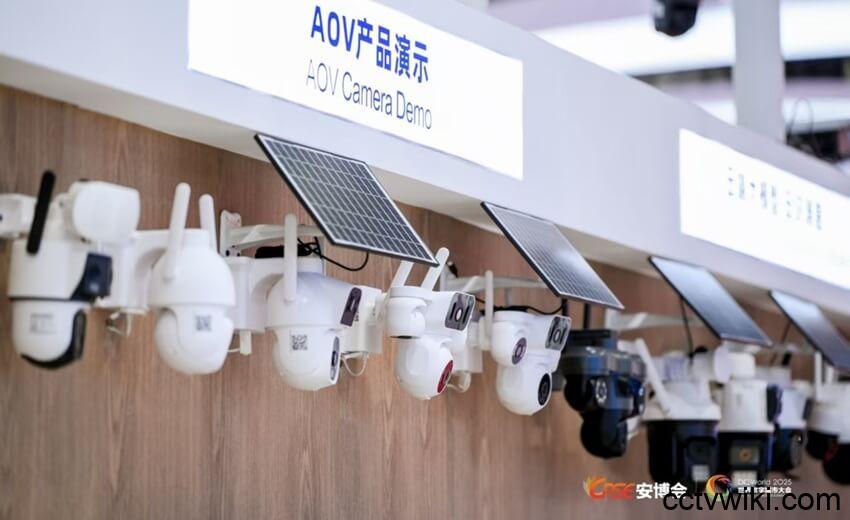At this year’s China International Exhibition on Public Safety and Security (CPSE), Always-On Video (AOV) cameras emerged as a dominant force, signaling a potential paradigm shift in the video surveillance industry. This article delves into the AOV products and solutions that captivated attendees, drawing insights from a&s China’s comprehensive coverage of the event.
AOV Cameras: A Market in Full Bloom
For years, the video surveillance sector has grappled with persistent challenges: the logistical hurdles of deploying cameras in areas lacking power or network infrastructure, unreliable connections in harsh conditions, frequent false alarms, and escalating operational and maintenance costs. AOV cameras offer a compelling solution, enabling monitoring in environments where traditional wired setups are impractical or impossible. By intelligently switching between high-frame, high-resolution recording during events and low-frame, low-power mode during periods of inactivity, AOV cameras achieve continuous 24/7 video capture while dramatically reducing energy consumption. This adaptability makes them ideally suited for a diverse range of applications, from residential properties and remote construction sites to retail parks and expansive urban perimeters.
This year’s CPSE underscored the burgeoning popularity of AOV technology. Over 60% of camera exhibitors showcased AOV product lines, and these solutions accounted for a remarkable 45% of the Smart Video Monitoring Pavilion. Data collected from the event further revealed that AOV cameras have already secured a place on the procurement lists of numerous international buyers targeting China’s security market, with particularly robust demand growth in rapidly expanding markets like Southeast Asia and the Middle East.
Technological Advancement Meets Cost-Effectiveness
The widespread adoption of AOV technology can be attributed to significant technological breakthroughs and a more streamlined cost structure. In the chip manufacturing sector, companies such as SigmaStar, Fullhan, and HiSilicon have introduced specialized AI chips that substantially enhance the computing power and energy efficiency of AOV cameras. This allows these cameras to perform complex AI analytics at the edge, eliminating the need for cloud-based processing. On the algorithmic front, advancements in lightweight AI models enable devices to maintain high detection accuracy even in low-power mode, filtering out 95% of irrelevant scenes in mere milliseconds.
Several exhibitors highlighted that increased localization of key components sourcing and manufacturing has driven down AOV camera prices by 40% compared to three years ago, bringing them into a similar price range as mid- to high-end PIR cameras. This combination of technological upgrades and cost reduction allows AOV products to meet the demands of professional applications while aligning with the price expectations of consumer markets, paving the way for mass adoption.
A Showcase of AOV Innovation
CPSE 2025 served as a platform for showcasing the latest AOV camera innovations, with companies leveraging their technological strengths and market positioning to develop differentiated solutions.
Tiandy’s AOV 3.0
Tiandy unveiled its AOV 3.0 system, featuring a real-time charging efficiency prediction capability that not only monitors remaining battery power but also forecasts future solar energy input. Algorithmically, AOV 3.0 filters out 95% of invalid scenes (such as shadows and moving leaves) within 5 milliseconds, reducing detection time by 90% and lowering overall device power consumption by 20%. On the hardware front, the AOV camera precisely synchronizes supplemental lighting with sensor exposure, eliminating energy waste and reducing nighttime power consumption by an additional 20%.
Antai’s Intelligent AOV with Precise Target Detection
Antai introduced its AOV smart camera series, capable of accurately identifying moving object types (people, vehicles, and animals), thereby significantly reducing false alarm rates. Its integrated chip analyzes object features and behavior in real-time, triggering alarms only for genuine threats. According to Antai representatives, their AOV products have been exported to Europe, the U.S., APAC, the Middle East, and Africa, with global shipments in 2025 experiencing a substantial increase.
Ruision Technology showcased its AOV series, including the XF5H low-light full-color AOV bullet-PTZ hybrid camera. This camera boasts multi-sensor imaging, producing 8MP ultra-clear capture, 24-hour recording, active scene detection, 1.0 TOPS computing power, exceptional audio-video processing, and ultra-low-power operation for extended runtime.
AI Chips Tailored for AOV Cameras
In the IC Pavilion, SigmaStar, Fullhan, and SmartSens, among others, presented AI chips specifically designed for AOV cameras. By optimizing compute power allocation, these chips reduce power consumption by over 30% while maintaining robust AI performance. “Demand for chips is rising as AOV technology advances, and chip innovation is, in turn, accelerating AOV adoption,” stated a spokesperson for SigmaStar, which has forged strong partnerships with numerous AOV manufacturers.
Diverse Application Scenarios Emerge
Advancements in AOV technology are not limited to performance enhancements; they are also driving deployment in a wide array of applications. At CPSE, companies shifted their focus from individual products to integrated solutions tailored to specific use cases.
For homes and small businesses, Antai’s AOV series offers a compelling combination of cost-efficiency and ease of use. Its products support mobile app control, detection zone customization, alarm configuration, and human/face recognition, enabling users to distinguish between family members and strangers. For SMEs, Antai also launched bundled solutions that integrate AOV cameras, NVRs, and PoE devices, facilitating rapid deployment without the need for professional installation.
AOV cameras are also gaining traction in emerging fields such as low-altitude security and smart agriculture. In low-altitude security, AOV cameras with multimodal sensing accurately identify drones, enabling intelligent tracking of low-flying objects. In smart agriculture, AOV-enabled devices can detect crop growth and pest conditions and even differentiate between wildlife and livestock, providing comprehensive protection for agricultural operations.
The Future is AOV
AOV cameras are undeniably the rising stars of the video surveillance industry. With their superior power management, network connectivity, and intelligent features, these cameras are experiencing increased adoption across diverse sectors, from SMEs to smart agriculture. Looking ahead, we can anticipate even greater market acceptance and renewed growth in the safe city and digital living spaces, cementing AOV technology’s position as a key driver of innovation in the security landscape.

